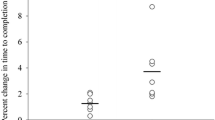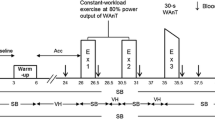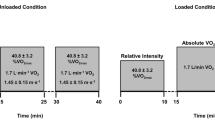Abstract
This study tested the hypothesis that live high, train low (LHTL) would increase submaximal exercise ventilation (V̇E) in normoxia, and the increase would be related to enhanced hypoxic ventilatory response (HVR). Thirty-three cyclists/triathletes were divided into three groups: 20 consecutive nights of hypoxia (LHTLc, n=12), 20 nights of intermittent hypoxia (4×5-night ‘blocks’ of hypoxia interspersed by two nights of normoxia, LHTLi, n=10), or control (CON, n=11). LHTLc and LHTLi slept 8–10 h per night in normobaric hypoxia (2,650 m), and CON slept under ambient conditions (600 m). Resting, isocapnic HVR (ΔV̇E/Δblood oxygen saturation) was measured in normoxia before (PRE) and after 15 nights (N15) hypoxia. Submaximal cycle ergometry was conducted PRE and after 4, 10, and 19 nights of hypoxia (N4, N10, and N19 respectively). Mean submaximal exercise V̇E was increased (P<0.05) from PRE to N4 in LHTLc [74.4 (5.1) vs 80.0 (8.4) l min−1; mean (SD)] and in LHTLi [69.0 (7.5) vs 76.9 (7.3) l min−1] and remained elevated in both groups thereafter, with no changes observed in CON at any time. Prior to LHTL, submaximal V̇E was not correlated with HVR, but this relationship was significant at N4 (r=0.49, P=0.03) and N19 (r=0.77, P<0.0001). Additionally, the increases in submaximal V̇E and HVR from PRE to N15–N19 were correlated (r=0.51, P=0.02) for the pooled data of LHTLc and LHTLi. These results suggest that enhanced hypoxic chemosensitivity contributes to increased exercise V̇E in normoxia following LHTL.





Similar content being viewed by others
References
Ashenden MJ, Gore CJ, Dobson GP, Hahn AG (1999) ‘Live high, train low’ does not change the total haemoglobin mass of male endurance athletes sleeping at a simulated altitude of 3,000 m for 23 nights. Eur J Appl Physiol 80:479–484
Bisgard GE, Forster HV (1996) Ventilatory responses to acute and chronic hypoxia. In: Fregly MJ and Blatteis CM (eds) Handbook of physiology, section 4, Environmental physiology. Oxford University Press, New York, pp 1207–1239
Buskirk ER, Kollias J, Akers RF, Prokop EK, Reategui EP (1967) Maximal performance at altitude and on return from altitude in conditioned runners. J Appl Physiol 23:259–266
Clark SA, Aughey RJ, Gore CJ, Hahn AG, Townsend NE, Kinsman TA, Chow CM, McKenna MJ, Hawley JA (2004) Effects of live-high, train-low hypoxic exposure on lactate metabolism in trained humans. J Appl Physiol 96:517–525
Daniels J, Oldridge N (1970) The effects of alternate exposure to altitude and sea level on world-class middle-distance runners. Med Sci Sports 2:107–112
Dempsey JA (1986) J. B. Wolffe memorial lecture. Is the lung built for exercise? Med Sci Sports Exerc 18:143–155
Dempsey JA, Forster HV (1982) Mediation of ventilatory adaptations. Physiol Rev 62:262–346
Dempsey JA, Wagner PD (1999) Exercise-induced arterial hypoxemia. J Appl Physiol 87:1997–2006
Dempsey JA, Forster HV, Birnbaum ML, Reddan WG, Thoden J, Grover RF, Rankin J (1972) Control of exercise hyperpnea under varying durations of exposure to moderate hypoxia. Respir Physiol 16:213–231
Dempsey JA, Forster HV, Bisgard GE, Chosy LW, Hanson PG, Kiorpes AL, Pelligrino DA (1979) Role of cerebrospinal fluid [H+] in ventilatory deacclimatization from chronic hypoxia. J Clin Invest 64:199–205
Dempsey JA, Hanson PG, Henderson KS (1984) Exercise-induced arterial hypoxaemia in healthy human subjects at sea level. J Physiol (Lond) 355:161–175
Dill DB, Adams WC (1971) Maximal oxygen uptake at sea level and at 3,090 m altitude in high school champion runners. J Appl Physiol 30:854–859
Durand F, Mucci P, Prefaut C (2000) Evidence for an inadequate hyperventilation inducing arterial hypoxemia at submaximal exercise in all highly trained endurance athletes. Med Sci Sports Exerc 32:926–932
Engwall MJ, Bisgard GE (1990) Ventilatory responses to chemoreceptor stimulation after hypoxic acclimatization in awake goats. J Appl Physiol 69:1236–1243
Fatemian M, Robbins PA (1998) Human ventilatory response to CO2 after 8 h of isocapnic or poikilocapnic hypoxia. J Appl Physiol 85:1922–1928
Faulkner JA, Daniels JT, Balke B (1967) Effects of training at moderate altitude on physical performance capacity. J Appl Physiol 23:85–89
Forster HV, Klausen K (1973) The effect of chronic metabolic acidosis and alkalosis on ventilation during exercise and hypoxia. Respir Physiol 17:336–346
Garcia N, Hopkins SR, Elliott AR, Aaron EA, Weinger MB, Powell FL (2001) Ventilatory response to 2-h sustained hypoxia in humans. Respir Physiol 124:11–22
Garcia N, Hopkins SR, Powell FL (2000) Effects of intermittent hypoxia on the isocapnic hypoxic ventilatory response and erythropoiesis in humans. Respir Physiol 123:39–49
Gavin TP, Derchak PA, Stager JM (1998) Ventilation’s role in the decline in V̇O2max and SaO2 in acute hypoxic exercise. Med Sci Sports Exerc 30:195–199
Gore CJ, Crockett AJ, Pederson DG, Booth ML, Bauman A, Owen N (1995) Spirometric standards for healthy adult lifetime nonsmokers in Australia. Eur Respir J 8:773–782
Gore CJ, Hahn AG, Aughey RJ, Martin DT, Ashenden MJ, Clark SA, Garnham AP, Roberts AD, Slater GJ, McKenna MJ (2001) Live high:train low increases muscle buffer capacity and submaximal cycling efficiency. Acta Physiol Scand 173:275–286
Hahn AG, Gore CJ, Martin DT, Ashenden MJ, Roberts AD, Logan PA (2001) An evaluation of the concept of living at moderate altitude and training at sea level. Comp Biochem Physiol A Mol Integr Physiol 128:777–789
Harms CA, Stager JM (1995) Low chemoresponsiveness and inadequate hyperventilation contribute to exercise-induced hypoxemia. J Appl Physiol 79:575–580
Hopkins SR, McKenzie DC (1989) Hypoxic ventilatory response and arterial desaturation during heavy work. J Appl Physiol 67:1119–1124
Johnson BD, Saupe KW, Dempsey JA (1992) Mechanical constraints on exercise hyperpnea in endurance athletes. J Appl Physiol 73:874–886
Katayama K, Sato Y, Shima N, Qiu JC, Ishida K, Mori S, Miyamura M (2002) Enhanced chemosensitivity after intermittent hypoxic exposure does not affect exercise ventilation at sea level. Eur J Appl Physiol 87:187–191
Levine BD, Friedman DB, Engfred K, Hanel B, Kjaer M, Clifford PS, Secher NH (1992) The effect of normoxic or hypobaric hypoxic endurance training on the hypoxic ventilatory response. Med Sci Sports Exerc 24:769–775
Mahamed S, Duffin J (2001) Repeated hypoxic exposures change respiratory chemoreflex control in humans. J Physiol (Lond) 534:595–603
Mahamed S, Cunningham DA, Duffin J (2003) Changes in respiratory control after three hours of isocapnic hypoxia in humans. J Physiol 547:271–281
Martin BJ, Weil JV, Sparks KE, McCullough RE, Grover RF (1978) Exercise ventilation correlates positively with ventilatory chemoresponsiveness. J Appl Physiol 45:557–564
McMahon ME, Boutellier U, Smith RM, Spengler CM (2002) Hyperpnea training attenuates peripheral chemosensitivity and improves cycling endurance. J Exp Biol 205:3937–3943
Rice AJ, Scroop GC, Gore CJ, Thornton AT, Chapman MA, Greville HW, Holmes MD, Scicchitano R (1999) Exercise-induced hypoxaemia in highly trained cyclists at 40% peak oxygen uptake. Eur J Appl Physiol 79:353–359
Sato M, Severinghaus JW, Powell FL, Xu FD, Spellman MJ (1992) Augmented hypoxic ventilatory response in men at altitude. J Appl Physiol 73:101–107
Sato M, Severinghaus JW, Bickler P (1994) Time course of augmentation and depression of hypoxic ventilatory responses at altitude. J Appl Physiol 77:313–316
Tansley JG, Fatemian M, Howard LS, Poulin MJ, Robbins PA (1998) Changes in respiratory control during and after 48 h of isocapnic and poikilocapnic hypoxia in humans. J Appl Physiol 85:2125–2134
Townsend NE, Gore CJ, Hahn AG, McKenna MJ, Aughey RJ, Clark SA, Kinsman T, Hawley JA, Chow CM (2002) Living high-training low increases hypoxic ventilatory response of well-trained endurance athletes. J Appl Physiol 93:1498–1505
Weil JV, Byrne-Quinn E, Sodal IE, Friesen WO, Underhill B, Filley GF, Grover RF (1970) Hypoxic ventilatory drive in normal man. J Clin Invest 49:1061–1072
Weil JV, Byrne-Quinn E, Sodal IE, Kline JS, McCullough RE, Filley GF (1972) Augmentation of chemosensitivity during mild exercise in normal man. J Appl Physiol 33:813–819
Wetter TJ, Harms CA, Nelson WB, Pegelow DF, Dempsey JA (1999) Influence of respiratory muscle work on V̇O2 and leg blood flow during submaximal exercise. J Appl Physiol 87:643–651
Whipp BJ (1994) Peripheral chemoreceptor control of exercise hyperpnea in humans. Med Sci Sports Exerc 26:337–347
Acknowledgements
The authors wish to acknowledge the support of BOC Gases Australia for supply of resources, equipment, and technical assistance, Mr. Colin Mackintosh for software development and support, and Mr. Rob Shugg and Mr. Evan Lawton for technical assistance. This study was funded by an Australian Research Council grant (no. C00002552).
Author information
Authors and Affiliations
Corresponding author
Rights and permissions
About this article
Cite this article
Townsend, N.E., Gore, C.J., Hahn, A.G. et al. Hypoxic ventilatory response is correlated with increased submaximal exercise ventilation after live high, train low. Eur J Appl Physiol 94, 207–215 (2005). https://doi.org/10.1007/s00421-004-1252-9
Accepted:
Published:
Issue Date:
DOI: https://doi.org/10.1007/s00421-004-1252-9




